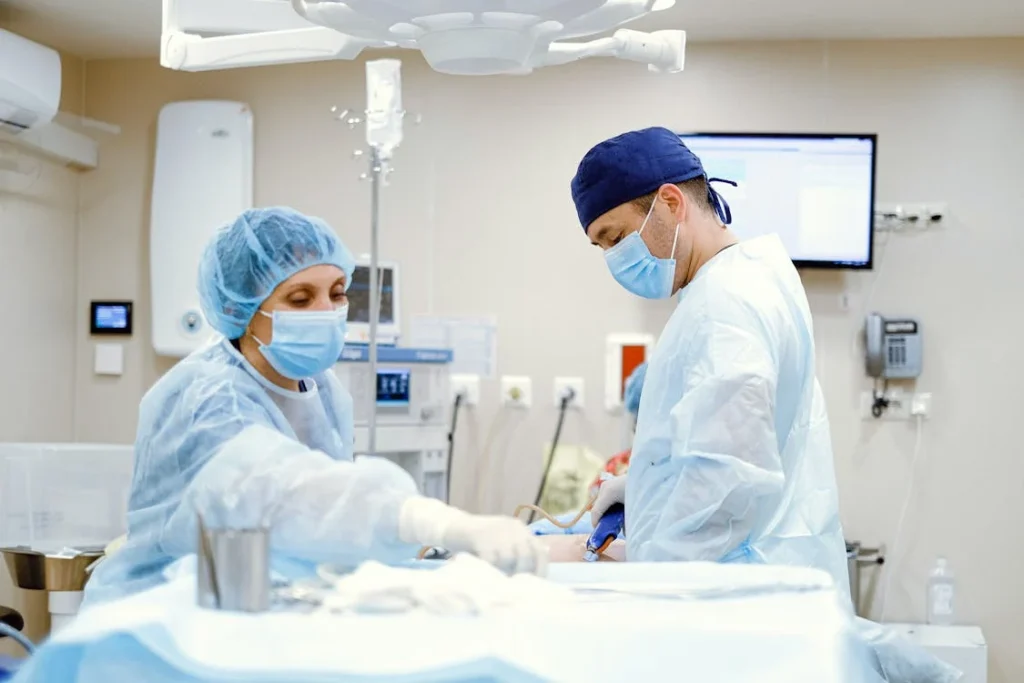Certified Registered Nurse Anesthetists (CRNAs) are essential contributors to enhancing surgical protocols and ensuring patient safety. With advanced education and specialized training, these highly skilled professionals administer anesthesia, monitor patient vital signs, and collaborate closely with surgical teams.
AANA states that about 57,000 CRNAs are currently working across the United States. These professionals play a crucial role in the healthcare system, providing anesthesia care in diverse settings. You’ll find them in hospitals, outpatient care centers, physicians’ offices, and specialty hospitals, ensuring patients receive top-notch anesthetic support wherever they are.
Their expertise contributes to more efficient surgical procedures while helping in minimizing complications and improving patient outcomes. As healthcare continues to evolve, the role of CRNAs is increasingly recognized as vital in delivering high-quality anesthetic care.
Collaborative Surgical Teams
AMN Healthcare notes that the CRNA credential has a rich history, having been established over 67 years ago in 1956. However, nurse anesthetists have been delivering care in the United States for nearly a century before that. Today, CRNAs administer over 50 million anesthetics annually and represent more than 50% of the anesthesia workforce, highlighting their vital role in patient care.
The integration of Certified Registered Nurse Anesthetists into surgical teams fosters a collaborative approach to patient care. CRNAs collaborate with anesthesiologists, surgeons, and other medical specialists to create customized anesthetic plans that meet the requirements of each patient. From preoperative evaluations to postoperative recuperation, this partnership guarantees that every facet of a patient’s care is taken into account.
CRNAs provide valuable insights into patient health status by participating in preoperative discussions and surgical briefings. They also identify potential risks, enhancing overall surgical protocol efficiency. Their presence in surgical teams improves communication among providers. Additionally, it instills confidence in patients, knowing they are receiving comprehensive care from a skilled multidisciplinary team.
What impact do CRNAs have on surgical team dynamics?
CRNAs foster collaboration within surgical teams by enhancing communication among team members. Their insights during preoperative assessments ensure all aspects of patient care are considered. This collaborative atmosphere improves workflow efficiency and contributes to better patient outcomes during surgery.
Improving Patient Safety
One of the primary responsibilities of CRNAs is to enhance patient safety during surgical procedures. With their advanced training, they are equipped to identify and manage potential complications related to anesthesia, ensuring that patients remain stable throughout their surgeries.
Cureus reports that the fields of surgery and anesthesiology have evolved hand in hand, with advances in anesthesiology enabling remarkable surgical progress. The introduction of less invasive techniques has streamlined anesthetic procedures while significantly reducing the need for blood transfusions.
Thanks to pioneering advancements, the risk associated with anesthesia has plummeted. The mortality rate has decreased from 6.4 deaths per 10,000 operations in the 1940s to under one per 200,000 today.
This has been possible because CRNAs conduct thorough preoperative evaluations, assessing medical histories, allergies, and other factors that could influence anesthesia administration.
During surgery, they continuously monitor vital signs and respond promptly to any changes, adjusting anesthesia levels as necessary. This careful monitoring makes the operating room safer by preventing unfavorable outcomes. CRNAs prioritize patient safety, which helps to reduce risks and improve the overall quality of care in the operating room.
Educational Foundations of CRNAs
A Bachelor of Science in Nursing (BSN) and experience as a registered nurse are prerequisites for becoming a CRNA.
According to Rockhurst University, this foundational education equips them with critical nursing skills and a deep understanding of patient care. After obtaining their BSN, aspiring CRNAs typically pursue a master’s or doctoral degree in nurse anesthesia. Under this program, they receive advanced training in anesthesia administration, pharmacology, and patient assessment.
Forbes mentions that obtaining these degrees usually takes around two years and combines hands-on practice with advanced coursework tailored for a nursing career. If you’re looking to accelerate your education, consider enrolling in a BSN-to-MSN program, which allows you to pursue both degrees simultaneously. This option saves time while setting you up for advanced opportunities in the nursing field.
This extensive educational background ensures that CRNAs are well-prepared to manage complex cases and make informed decisions that prioritize patient safety.
In addition to their educational qualifications, CRNAs must obtain state licensure to practice. For example, in Missouri, CRNAs must obtain a Missouri APRN license to work as an advanced practice registered nurse. This licensure confirms their qualifications while allowing them to function autonomously in various healthcare environments.
The Missouri APRN license empowers CRNAs to perform critical functions, such as prescribing anesthesia and managing patient care during surgical procedures. Other states also follow a similar licensure process, ensuring that CRNAs across the country meet stringent educational and competency standards. This regulatory structure is critical for ensuring high levels of patient safety and quality treatment in anesthetic services.
Are there any continuing education requirements for CRNAs?
Yes, CRNAs must do continuing education to keep their certification. This continual education guarantees that they keep up to date on the most recent advances in anesthetic methods and technologies. CRNAs uphold high standards of care in their field by fulfilling these requirements.
Streamlining Recovery Processes
CRNAs are instrumental in streamlining recovery processes following surgery, ultimately leading to improved patient outcomes. CRNAs can effectively help manage pain while minimizing reliance on opioids by employing multimodal anesthesia techniques.
This reduces the risk of complications such as respiratory depression. Their expertise in pain management allows for tailored recovery plans that facilitate quicker transitions from anesthesia to post-anesthesia care.
Additionally, CRNAs educate patients and their families about postoperative care, covering pain management strategies and identifying signs of potential complications.
CRNAs help facilitate shorter hospital stays and quicker returns to normal activities by enhancing recovery protocols and supporting patients during recovery. Their contributions significantly showcase their invaluable role in the overall surgical process and patient care.
What role do CRNAs play in patient education?
CRNAs take the time to educate patients about the anesthesia process, ensuring all their questions are answered. They outline what patients can expect both during and after the surgery, which helps to alleviate anxiety. This proactive approach fosters a strong partnership between patients and healthcare providers, enhancing the overall surgical experience.
CRNAs play an essential role in surgical procedures, and their impact on patient care is huge. With advanced education and specialized training, these professionals elevate surgical outcomes and bolster patient safety. Their expertise in administering anesthesia, monitoring patients, and managing pain means that individuals receive top-notch care every step of the way.
As the healthcare landscape changes, CRNAs will continue to be vital in providing safe and effective anesthesia care. This ensures that patients feel secure and well-supported during their surgical experiences. Their contributions make a real difference in the operating room and beyond.



